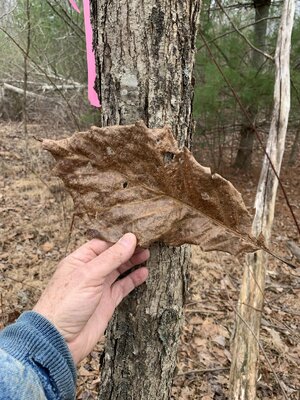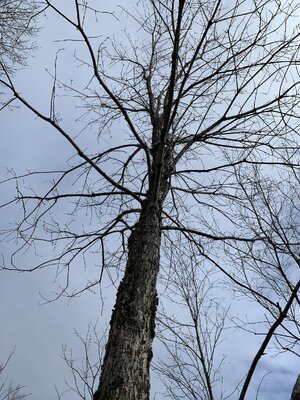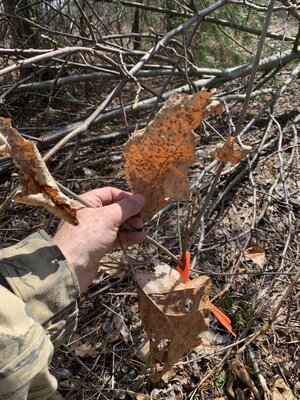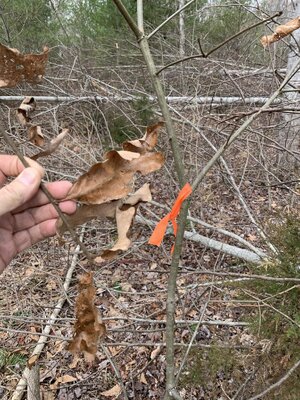Native Hunter
Well-Known Member
Over the last few years, you guys have seen me post a lot about persimmons, apples, pears and chestnuts. I still love all those trees, but this year I’m turning my attention to the oak trees that I set out 15-17 years ago.
The original planting was done in 2004, but we had a severe drought that year, and I did replacements over the next two years on trees that died. So in the spring of 2021, these trees will range from 15 to 17 years in the ground. The area planted is flat upland loam with good moisture but not swampy.
I set around 12 acres in trees. The rows were planted 13 feet apart to facilitate mowing for the first few years and the trees were set 7 feet apart within each row. This is too close, but some will die, and you can always thin later if necessary.
I was told that these trees came from MDC, but I’m really unsure about that. I bought them second hand from a guy who was doing a lot of CRP plantings, and he dealt with several different tree vendors. What I’ve found is that I ended up with several more varieties than I was supposed to have, which I feel is a good thing because it makes the planting more diverse. All oaks don’t bloom at the same time, and the more species you have, the better chance in any given year of getting acorns if a late spring freeze hits.
Up to this point, I have paid very little attention to these trees other than cutting and stump treating volunteer competition that popped up. This has mainly been sweet gums, but I have also cut some other species.
This thread is to provide identification keys and information about several different oaks that I found in the planting. We will look at pictures and have discussions about the different species. I hope to post a different oak every week or two weeks for us to discuss. I encourage everyone interested to participate in the discussions and share your information.
Below is a list of Oaks I have already identified in the planting, and we might find some more species as I look closer this year:
White Oak - Quercus alba
Swamp White Oak - Quercus bicolor
Swamp Chestnut Oak - Quercus michauxii
Chinkapin Oak - Quercus muehlenbergii
Post Oak - Quercus stellata
Bur Oak - Quercus macrocarpa
Overcup Oak - Quercus lyrata
Cherry Bark Oak - Quercus pagoda
Northern Red Oak - Quercus rubra
Pin Oak - Quercus palustris
Black Oak - Quercus velutina
Sawtooth Oak – Quercus acutissima (added a few years later)
I’m going to start this thread by identifying and providing information on an oak that I’m very happy to see doing well. Below you will see Swamp Chestnut Oak - Quercus michauxii. I recall setting these as replacement trees two years after the initial planting, so they have been growing 15 years. I haven’t counted them, but I know that there are well over 60 or more thriving in the planting.
Facts about this oak:
· A member of the white oak family.
· Highly prized whitetail acorn of a large size with low tannin. Some reports say that humans can eat them without leaching.
· Bottomland species but growing well on my damp upland site. I estimate most trees are 30+ feet tall after 15 years.
· Leaves resemble regular Chestnut Oak, but bark is very different. Acorns and caps also look very different.
· I know that I have been getting acorns, because I’ve found some young seedlings nearby. That made me happy.
Some pics of leaves, bark and form:




That’s it for now. I will post another oak in a few days and feel free to ask questions or make comment in the meantime.
The original planting was done in 2004, but we had a severe drought that year, and I did replacements over the next two years on trees that died. So in the spring of 2021, these trees will range from 15 to 17 years in the ground. The area planted is flat upland loam with good moisture but not swampy.
I set around 12 acres in trees. The rows were planted 13 feet apart to facilitate mowing for the first few years and the trees were set 7 feet apart within each row. This is too close, but some will die, and you can always thin later if necessary.
I was told that these trees came from MDC, but I’m really unsure about that. I bought them second hand from a guy who was doing a lot of CRP plantings, and he dealt with several different tree vendors. What I’ve found is that I ended up with several more varieties than I was supposed to have, which I feel is a good thing because it makes the planting more diverse. All oaks don’t bloom at the same time, and the more species you have, the better chance in any given year of getting acorns if a late spring freeze hits.
Up to this point, I have paid very little attention to these trees other than cutting and stump treating volunteer competition that popped up. This has mainly been sweet gums, but I have also cut some other species.
This thread is to provide identification keys and information about several different oaks that I found in the planting. We will look at pictures and have discussions about the different species. I hope to post a different oak every week or two weeks for us to discuss. I encourage everyone interested to participate in the discussions and share your information.
Below is a list of Oaks I have already identified in the planting, and we might find some more species as I look closer this year:
White Oak - Quercus alba
Swamp White Oak - Quercus bicolor
Swamp Chestnut Oak - Quercus michauxii
Chinkapin Oak - Quercus muehlenbergii
Post Oak - Quercus stellata
Bur Oak - Quercus macrocarpa
Overcup Oak - Quercus lyrata
Cherry Bark Oak - Quercus pagoda
Northern Red Oak - Quercus rubra
Pin Oak - Quercus palustris
Black Oak - Quercus velutina
Sawtooth Oak – Quercus acutissima (added a few years later)
I’m going to start this thread by identifying and providing information on an oak that I’m very happy to see doing well. Below you will see Swamp Chestnut Oak - Quercus michauxii. I recall setting these as replacement trees two years after the initial planting, so they have been growing 15 years. I haven’t counted them, but I know that there are well over 60 or more thriving in the planting.
Facts about this oak:
· A member of the white oak family.
· Highly prized whitetail acorn of a large size with low tannin. Some reports say that humans can eat them without leaching.
· Bottomland species but growing well on my damp upland site. I estimate most trees are 30+ feet tall after 15 years.
· Leaves resemble regular Chestnut Oak, but bark is very different. Acorns and caps also look very different.
· I know that I have been getting acorns, because I’ve found some young seedlings nearby. That made me happy.
Some pics of leaves, bark and form:




That’s it for now. I will post another oak in a few days and feel free to ask questions or make comment in the meantime.
Last edited:


